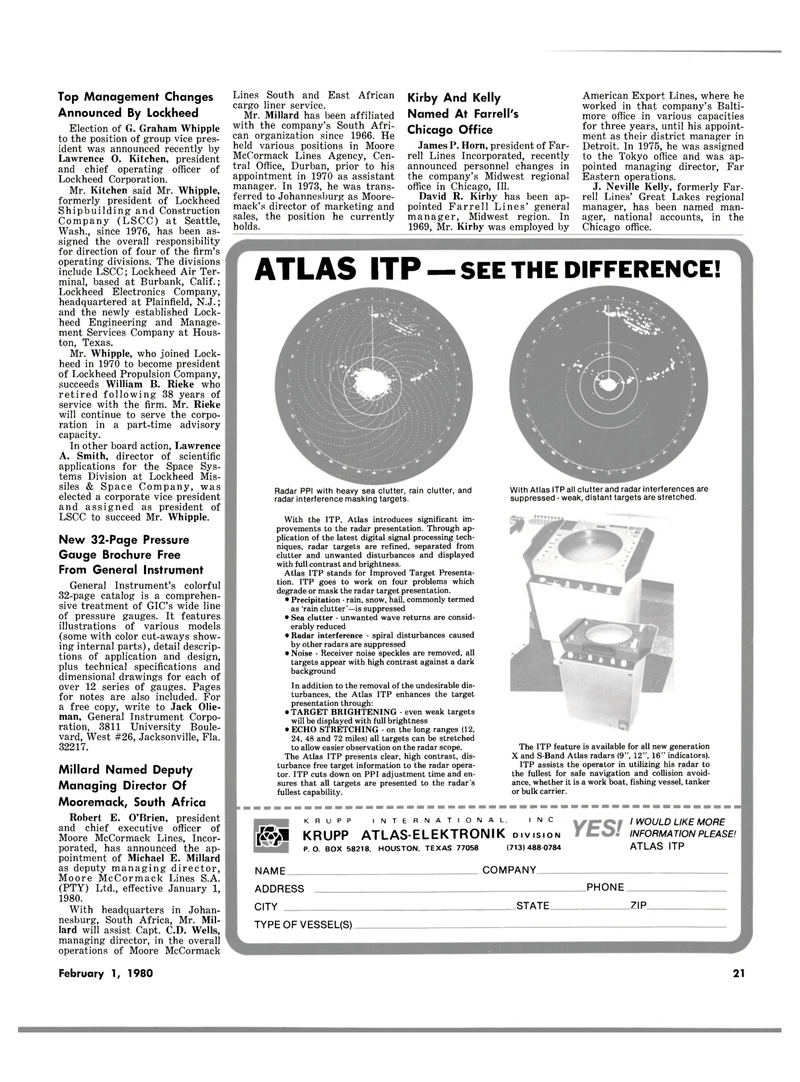
Page 19: of Maritime Reporter Magazine (February 1980)
Read this page in Pdf, Flash or Html5 edition of February 1980 Maritime Reporter Magazine
Top Management Changes
Announced By Lockheed
Election of G. Graham Whipple to the position of group vice pres- ident was announced recently by
Lawrence O. Kitchen, president and chief operating officer of
Lockheed Corporation.
Mr. Kitchen said Mr. Whipple, formerly president of Lockheed
Shipbuilding and Construction
Company (LSCC) at Seattle,
Wash., since 1976, has been as- signed the overall responsibility for direction of four of the firm's operating divisions. The divisions include LSCC; Lockheed Air Ter- minal, based at Burbank, Calif.;
Lockheed Electronics Company, headquartered at Plainfield, N.J.; and the newly established Lock- heed Engineering and Manage- ment Services Company at Hous- ton, Texas.
Mr. Whipple, who joined Lock- heed in 1970 to become president of Lockheed Propulsion Company, succeeds William B. Rieke who retired following 38 years of service with the firm. Mr. Rieke will continue to serve the corpo- ration in a part-time advisory capacity.
In other board action, Lawrence
A. Smith, director of scientific applications for the Space Sys- tems Division at Lockheed Mis- siles & Space Company, was elected a corporate vice president and assigned as president of
LSCC to succeed Mr. Whipple.
New 32-Page Pressure
Gauge Brochure Free
From General Instrument
General Instrument's colorful 32-page catalog is a comprehen- sive treatment of GIC's wide line of pressure gauges. It features illustrations of various models (some with color cut-aways show- ing internal parts), detail descrip- tions of application and design, plus technical specifications and dimensional drawings for each of over 12 series of gauges. Pages for notes are also included. For a free copy, write to Jack Olie- man, General Instrument Corpo- ration, 3811 University Boule- vard, West #26, Jacksonville, Fla. 32217.
Millard Named Deputy
Managing Director Of
Mooremack, South Africa
Robert E. O'Brien, president and chief executive officer of
Moore McCormack Lines, Incor- porated, has announced the ap- pointment of Michael E. Millard as deputy managing director,
Moore McCormack Lines S.A. (PTY) Ltd., effective January 1, 1980.
With headquarters in Johan- nesburg, South Africa, Mr. Mil- lard will assist Capt. C.D. Wells, managing director, in the overall operations of Moore McCormack
Lines South and East African cargo liner service.
Mr. Millard has been affiliated with the company's South Afri- can organization since 1966. He held various positions in Moore
McCormack Lines Agency, Cen- tral Office, Durban, prior to his appointment in 1970 as assistant manager. In 1973, he was trans- ferred to Johannesburg as Moore- mack's director of marketing and sales, the position he currently holds.
Kirby And Kelly
Named At Farrell's
Chicago Office
James P. Horn, president of Far- rell Lines Incorporated, recently announced personnel changes in the company's Midwest regional office in Chicago, 111.
David R. Kirby has been ap- pointed Farrell Lines' general manager, Midwest region. In 1969, Mr. Kirby was employed by
American Export Lines, where he worked in that company's Balti- more office in various capacities for three years, until his appoint- ment as their district manager in
Detroit. In 1975, he was assigned to the Tokyo office and was ap- pointed managing director, Far
Eastern operations.
J. Neville Kelly, formerly Far- rell Lines' Great Lakes regional manager, has been named man- ager, national accounts, in the
Chicago office.
ATLAS ITP — SEE THE DIFFERENCE!
Radar PPI with heavy sea clutter, rain clutter, and radar interference masking targets.
With Atlas ITP all clutter and radar interferences are suppressed - weak, distant targets are stretched.
With the ITP, Atlas introduces significant im- provements to the radar presentation. Through ap- plication of the latest digital signal processing tech- niques, radar targets are refined, separated from clutter and unwanted disturbances and displayed with full contrast and brightness.
Atlas ITP stands for Improved Target Presenta- tion. ITP goes to work on four problems which degrade or mask the radar target presentation. • Precipitation - rain, snow, hail, commonly termed as 'rain clutter'—is suppressed • Sea clutter - unwanted wave returns are consid- erably reduced • Radar interference - spiral disturbances caused by other radars are suppressed • Noise - Receiver noise speckles are removed, all targets appear with high contrast against a dark background
In addition to the removal of the undesirable dis- turbances, the Atlas ITP enhances the target presentation through: • TARGET BRIGHTENING - even weak targets will be displayed with full brightness • ECHO STRETCHING - on the long ranges (12, 24, 48 and 72 miles) all targets can be stretched to allow easier observation on the radar scope.
The Atlas ITP presents clear, high contrast, dis- turbance free target information to the radar opera- tor. ITP cuts down on PPI adjustment time and en- sures that all targets are presented to the radar's fullest capability.
The ITP feature is available for all new generation
X and S-Band Atlas radars (9", 12", 16" indicators).
ITP assists the operator in utilizing his radar to the fullest for safe navigation and collision avoid- ance, whether it is a work boat, fishing vessel, tanker or bulk carrier.
K R U P P INTERNATIONAL, I N C [KjJ KRUPP ATLAS-ELEKTRONIK • .VISION
P.O. BOX 58218, HOUSTON, TEXAS 77058 (713)488-0784
I WOULD LIKE MORE
INFORMATION PLEASE!
ATLAS ITP
NAME. COMPANY.
ADDRESS
CITY .PHONE. _ STATE. _ZIP_
TYPE OF VESSEL(S)_
February 1, 1980 21

 18
18

 20
20
